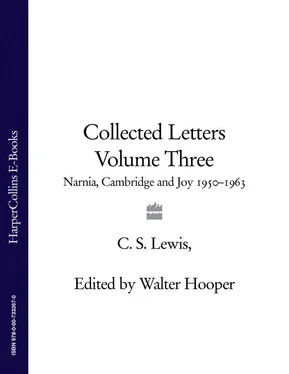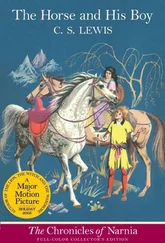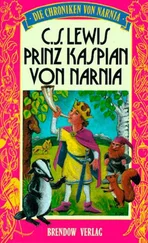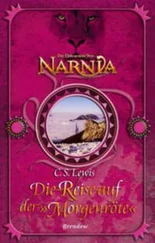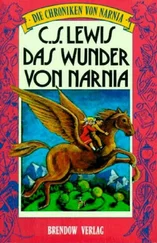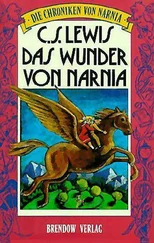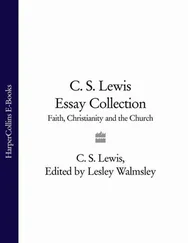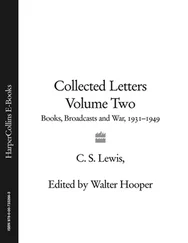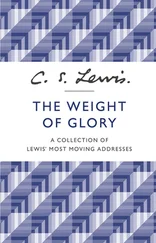38Bodle said of this letter: ‘I had spoken of a girl in my class at Manchester who was intelligent and had a great deal of language as she had acquired it before being deafened. In answer to her anxieties about the remoteness of God I had tried to explain who Christ is and why He had come. Then she herself said with unusual relief “Then Jesus is God”-a conception entirely new to her. I think that I must have been wondering how much of the teaching about Christ I could present with the Gospel story–a problem which I still find very difficult’ (Bodleian Library, MS. Eng. lett. c. 220/4, fols. 248-9).
39Acts 8:31.
40Matthew 6:12.
41See Sir Arthur Charles Clarkein the Biographical Appendix to CX II, pp. 1024-5.
42Clarke, in his capacity as chairman of the British Interplanetary Society, wrote to Lewis on 13 February 1953: ‘I am now trying to arrange this Society’s lecture programme for October ’53-April ’54, and the suggestion has been put forward that you might care to propose a notion that interplanetary travel is a bad thing!…It would be only fair to point out that your position might be somehow analogous to that of a Christian martyr in the arena, but I trust that consideration would not deter you’ (Bodleian Library, MS. Eng. lett. c. 220/4, fol. 16).
43Robin Oakley-Hill (1932-) was born on 30 May 1932, the son of Dayrell R. Oakley-Hill. He went up to Magdalen College, Oxford, in 1950 where he read English under Lewis. After taking his BA in 1953 he worked as an administrative officer in the Architects’ Department of the London City Council.
44In a note dated August 2003 Oakley-Hill said of this letter: ‘I was walking from the boathouse back to college on an unpleasantly raw winter afternoon after an unsatisfactory session of coxing when I was joined by CS Lewis waiting to cross the High. He said something like “You’re limping–did you hurt yourself?” I said no, I’d had polio, in a fairly unfriendly manner, because I was fed up with the weather, the unsatisfactory rowing and the tedious unfinished work I was going back to. He looked embarrassed and said “Oh, poor chap,” and we went our separate ways. I was astounded to get the letter next day, and was inclined to reply that it didn’t signify, but a confidant warned me to take the apology in a serious manner because otherwise it would seem that I did not appreciate the trouble he had taken in writing the letter, and I did so.’
45In the country of Brobdingnag in Jonathan Swift’s Gulliver’s Travels (1726) the people are as tall as steeples, and everything else is in proportion.
46Chad Walsh, Nellie and her Flying Crocodile , illus. Marc Simont (New York: Harper, 1956).
47That is, become an Associate of Holy Cross.
48Wilkie Collins, Armadale (1866).
49Wilkie Collins, The Woman in White (1860); The Moonstone (1868).
50In The Woman in White .
51Green, From the World’s End , ch. 5, p. 70. In Roman legend Tarquín raped Lucrece.
52ibid., p. 83: ‘a supreme surrender and a supreme assumption of responsibility.
53Theodore Watts-Dunton, Aylwin (1898).
54Green spelled the names ‘Danai’ and ‘Pasiphai’.
55i.e., The Last Battle (1956).
56Clifford W. Stone was writing from PO Box 528, El Dorado, Kansas.
57Mark Twain, Report from Paradise , with drawings by Charles Locke (New York: Harper & Bros., 1952). For many years Twain played with the idea of writing an account of heaven that would debunk Christian revelation. In 1909 he published ‘Captain Stormfield’s Visit to Heaven’, a fragment of his manuscript. Report from Paradise contains ‘Captain Stormfield’s Visit to Heaven’ as well as the other surviving chapters of Twain’s unfinished work.
58Mark Twain, A Connecticut Yankee in King Arthur’s Court (1889).
59For The Silver Chair .
60‘he is limping’.
61Shakespeare, King Lear , IV, vi, 133-4: ‘Give me an ounce of civet, good apothecary, to sweeten my imagination.’
62Palmer wanted Lewis to recommend one of his books to a publisher.
63Carroll, Through the Looking-Glass , ch. 6: ‘’Twas brillig, and the slithy toves/Did gyre and gimble in the wabe’.
64John Bunyan, The Life and Death of Mr. Badman (1680), ch. 8: ‘For they are a shame to religion, I say, these slithy, rob-shop, pick-pocket men, they are a shame to religion, and religious men should be ashamed of them.’
65The New English Dictionary , the precursor of the Oxford English Dictionary .
66See the reference to the eldila in the letter to Douglas Harding of 25 March 1951.
67e.g., Luke 1:30: ‘And the angel said unto her, Fear not, Mary: for thou hast found favour with God.’ See also Genesis 15:1; Luke 2:10.
68In Perelandra , ch. 16, p. 202, during the attempt to make themselves visible to Ransom, the eldila or Oyéresu of Mars and Venus appear as ‘concentric wheels moving with a rather sickening slowness one inside the other’. This imagery was inspired by the appearance of angels in Ezekiel 1:16: ‘Their appearance and their work was as it were a wheel in the middle of a wheel.’ We should notice too Miracles , ch. 14, pp. 120-1: ‘[Jahweh’s] appearance to Ezekiel is attended with imagery that does not borrow from Nature, but (it is a mystery too seldom noticed) from those machines which men were to make centuries after Ezekiel’s death. The prophet saw something suspiciously like a dynamo’
*This is not an afterthought. Mycroft funked it!
69‘Apiciarí had been added in Lewis’s hand.
70W. K. Scudamore was writing from 3 Maurice Road, Seaford, Sussex.
71This was Lewis’s ‘mangling’ of Scudamore’s name.
72Sir Scudamour is the lover of Amoret in Spenser’s The Faerie Queene , as well as the name of Lewis’s hero in The Dark Tower .
73Bodleian Library.
74Jane (‘Janie’) Agnes McNeill (1889-1959) was a close friend from Strandtown. See her biography in CL I, p. 117n.
75In his letter of 16 March 1953 Bles said: ‘With some trepidation I venture to address you again on the gender of mythological creatures…On returning to the galleys of “The Silver Chair”…I find the same thing has happened again, not only with the Dwarf but with that curious creature, the Marsh-wiggle…It looks to me as though the discrepancies are due to the fact that, although, for some philological reason, you try to keep Dwarf and Marsh-wiggle neuter, you naturally think of them as persons–as indeed most readers would. If I may say so, this neuter business seems strained and artificial, and in places reminds me of Mark Twain’s joke about the German language, “The girl took the spoon and fork. It laid him and her on the table’” (Bodleian Library, Dep. c. 771, fol. 20).
76Bles replied on 18 March 1953: ‘I am so glad that you agree to a “he” for the Dwarf and the Marshwiggle. I would suggest this Rule: when mythological creatures speak like human beings, masculine/feminine gender; when they are personae mutai [silent characters] neuter’ (ibid., fol. 22).
77Lewis probably had in mind the following three statements regarding natural law. The classical definition is found in St Thomas Aquinas: ‘The natural law is nothing other than the light of understanding placed in us by God; through it we know what we must do and what we must avoid. God has given this light or law at the creation’ (Collationes in decent praeceptis , 1). Cicero (51 BC) said in De Republica , 11:33: ‘There is in fact a true law–namely, right reason–which is in accordance with nature, applies to all men and is unchangeable and eternal.’ The chief New Testament text on which natural law is based is Romans 2:14-15: ‘When Gentiles who have not the law do by nature what the law requires, they are a law to themselves, even though they do not have the law. They show that what the law requires is written on their hearts, while their conscience also bears witness.’ Lewis’s writings on natural law include the first book of Mere Christianity, The Abolition of Man , and ‘The Poison of Subjectivism’ and ‘On Ethics’ in Christian Reflections .
Читать дальше
